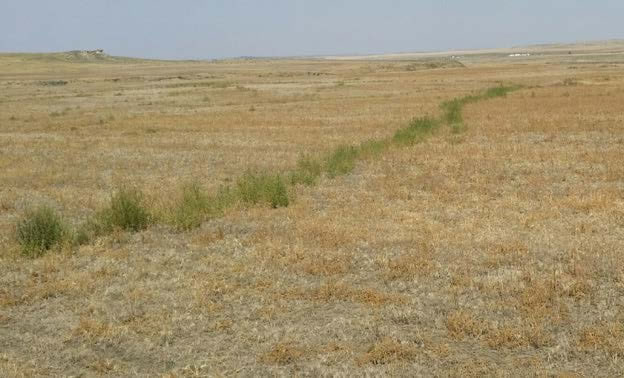Kochia and Russian Thistle: Omnipresent Weeds that will Only Get Tougher to Control
Tim Seipel, Extension Cropland Weed Specialist
Kochia (Kochia scoparia or also Bassia scoparia) and Russian thistle (Salsola kali) are the most problematic broadleaf weeds in Montana cropping systems. Over the last 70 years, but especially after the transition to no-till, these weeds have been managed using herbicides, however evolved herbicide resistance is making management harder. Herbicide resistance is the ability of a plant to tolerate an herbicide that once controlled it. Unfortunately, managing kochia and Russian thistle will only get tougher in the Northern Great Plains as many populations are resistant to commonly-used herbicides. In Montana and adjacent Alberta, populations of both species have been confirmed to be resistant to glyphosate (group 9) and ALS inhibitor (group 2) herbicides, and the frequency of herbicide- resistant populations is increasing.
Kochia

FIGURE 3. A glyphosate resistant kochia plant dispersed its seeds by tumbling in the wind, resulting in resistant offspring growing in a strip in a field in Montana. Photo credit Eric Miller.
In 2012 a survey of kochia in Alberta revealed that most glyphosate-resistant kochia was found in chemical fallow cropping systems. More follow-up surveys have identified other populations that are resistant to both ALS (group 2) and glyphosate (group 9). In 2017 in southern Alberta, Agriculture and Agri-Food Canada surveyed populations again and found glyphosate-resistant kochia in 15 of 16 municipal districts, while in 2012 it was only found in 3 of 16. They found 40% of populations had glyphosate resistance and approximately 40% of individuals in those populations were glyphosate resistant. These results underscore how fast herbicide resistance spreads. In Montana and Alberta most populations of kochia are resistant to group 2 ALS herbicides, and glyphosate resistance will also continue to spread.
What was also worrying about results from the 2017 survey was that resistance to dicamba (group 4) was found at almost 10% of sites. While this level of resistance is currently relatively low, it is concerning as the pattern suggests the frequency of dicamba resistance will increase as we are in the early stages of resistance evolution. Triple-resistant group 2 + group 9 + group 4 kochia was identified in 10% of populations sampled in southern Alberta. Evolution of group 4 resistance is alarming because we rely heavily on group 4 herbicides for control in wheat, and group 4 resistance will limit herbicide choices even more.
Russian thistle
Evolution of herbicide resistance in Russian thistle is also widespread in Montana, especially to group 2 herbicides, though evolution of resistance has been slower than in kochia. The first documented case of resistant Russian thistle in Montana occurred in 1987 to chlorsulfuron, an early ALS inhibitor (group 2) herbicide. In 2015, glyphosate-resistant Russian thistle was documented in Montana. In the 2017 survey in Alberta, group 2 resistant Russian thistle was found in 62% of populations in most municipal districts in southern Alberta. Russian thistle resistance is expected to increase quickly, and we should be on the lookout for more resistance.
What do we do? For both species we need a concerted effort by all stakeholders to manage these herbicide resistant weed populations. Best management practices can be utilized to slow the spread of these herbicide resistant weeds. Understanding the biology of the weeds can provide a strategy to exploit the species’ weakness. Maintain clean equipment and be cognizant of what is growing around the equipment. Reduce spread of seed, scout for plants that were not killed during herbicide applications and remove them. Use integrated weed management that includes cultural and mechanical weed control techniques. Have a diverse crop rotation, use different herbicide modes of action, and vary control techniques. In other words - keep the weeds guessing. The more predictable our management, the easier it is to evolve resistance to a single practice. For more information, consult MontGuides produced by Montana State University Extension, including Managing Herbicide Resistant Kochia [link has expired].
Originally published in the Spring 2019 issue of the Montana IPM Bulletin. For further information, contact Tim Seipel, Extension Cropland Weed Specialist.
